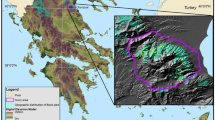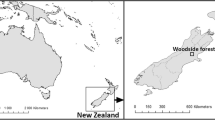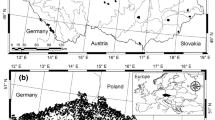Abstract
• Introduction
Understanding diameter growth of the Mediterranean pine species is fundamental for evaluating and making appropriate strategic decisions in forest management. A matrix diameter growth model for two Mediterranean pine forest ecosystems in Spain has been developed.
• Methods
Multinomial logistic (MNL) regression was employed to estimate the transition probabilities of a matrix growth model. The model combines individual tree and stand attributes and explores the effects of independent variables and their relationships with tree size and the probabilities of stand diameter growth. The aim was to predict growth of individual trees by diameter class for a 5-year period.
• Results
MNL model results for diameter growth gave better predictions for Maritime pine (Pinus pinaster Aiton) than for Scots pine (Pinus sylvestris L.). Stand simulations showed that diameter growth probabilities depended on productivity and stand density. Stand simulations under fixed conditions showed that the probabilities of diameter growth increased as site productivity increased and decreased with increased stand density index.
• Conclusions
This study demonstrates the usefulness of matrix growth models as tools to predict growth in Mediterranean pine forests. Stand density and site productivity are key factors in explaining Scots pine and Maritime pine forest growth in the study area.





Similar content being viewed by others
References
Boltz F, Carter DR (2006) Multinomial logit estimation of a matrix growth model for tropical dry forests of eastern Bolivia. Can J For Res 36:2623–2632
Bravo F, Montero G (2001) Site index estimation in Scots pine (Pinus sylvestris L.) stands in the High Ebro Basin (northern Spain) using soil attributes. Forestry 74:395–406
Bravo-Oviedo A, Del Río M, Montero G (2004) Site index curves and growth model for Mediterranean maritime pine (Pinus pinaster Ait.) in Spain. For Ecol Manage 201:187–197
Buongiorno J, Michie BR (1980) A matrix model of uneven-aged forest management. For Sci 26:609–625
Buongiorno J, Dahir S, Lu H-C et al (1994) Tree size diversity and economic returns in uneven-aged forest stands. For Sci 40:83–103
Buongiorno J, Peyron J-L, Houllier F et al (1995) Growth and management of mixed-species, uneven-aged forests in the French Jura: implications for economic returns and tree diversity. For Sci 41:397–429
Englin JE, McDonald JM, Moeltner K (2006) Valuing ancient forest ecosystems: an analysis of backcountry hiking in Jasper National Park. Ecol Econ 57:665–678
Greene WH (2000) Econometric analysis. Prentice Hall, Upper Saddle River, 860 pp
Hann DW, Hanus LM (2001) Enhanced mortality equations for trees in the mixed conifer zone of Southwest Oregon. For Res Lab Res Contrib 34:34
Hao QY, Meng FR, Zhu Y et al (2005) A transition matrix growth model for uneven-aged mixed-species forests in the Changbai Mountains, northeastern China. New For 29:221–231
Kurttila M, Hämäläinen K, Kajanus M et al (2001) Non-industrial private forest owners' attitudes towards the operational environment of forestry—a multinominal logit model analysis. For Policy Econ 2:13–28
Lin C-R, Buongiorno J, Prestemon J et al (1998) Growth model for uneven-aged Loblolly pine stands—simulations and management implications. Research Paper FPL-RP-569, USDA Forest Service, Forest Products Laboratory, Madison, WI
Lizarralde I (2008) Dinámica de rodales y competencias en las masas de pino silvestre (Pinus sylvestris L.) y pino negral (Pinus pinaster Ait.) de los Sistemas Central e Ibéricos. M.S. thesis, Universidad de Valladolid, Palencia, 230 pp
López Torres I, Fullana Belda C, Ortuño Pérez SF et al (2008) Choosing Fagus sylvatica L. matrix model dimension by sensitivity analysis of the population growth rate with respect to the width of the diameter classes. Ecol Model 218:307–314
Lowell KE, Mitchell RJ (1987) Stand growth projection—simultaneous estimation of growth and mortality using a single probabilistic function. Can J For Res 17:1466–1470
Lyhykäinen HT, Mäkinen H et al (2009) Predicting lumber grade and by-product yields for Scots pine trees. For Ecol Manage 258:146–158
McFadden D (1979) Quantitative methods for analysing travel behaviour of individual: some recent developments. In: Hensher DA, Stopher PR (eds) Behavioural travel modelling. Croom Helm, London, pp 279–318
Miina J (1993) Residual variation in diameter growth in a stand of Scots pine and Norway spruce. For Ecol Manage 58:111–128
Mogas J, Riera P et al (2006) A comparison of contingent valuation and choice modelling with second-order interactions. J For Econ 12:5–30
Monserud RA, Sterba H (1999) Modeling individual tree mortality for Austrian forest species. For Ecol Manage 113:109–123
Nagelkerke NJD (1991) A note on a general definition of the coefficient of determination. Biometrika 78:691–692
Osho JSA (1991) Matrix model for tree population projection in a tropical rain forest of south-western Nigeria. Ecol Model 59:247–255
Picard N, Bar-Hen A et al (2003) Modelling diameter class distribution with a second-order matrix model. For Ecol Manage 180:389–400
Prestemon JP, Buongiorno J (2000) Determinants of tree quality and lumber value in natural uneven-aged southern pine stands. Can J For Res 30:211–219
Prinzie A, Van den Poel D (2008) Random forests for multiclass classification: random multinomial logit. Expert Syst Appl 34:1721–1732
Río M, Bravo F et al (2004) Influence of individual tree and stand attributes in stem straightness in Pinus pinaster Ait. stands. Ann For Sci 61:141–148
Roberts MR, Hruska AJ (1986) Predicting diameter distributions—a test of the stationary Markov model. Can J For Res 16:130–135
SAS Institute Inc. (2004) SAS/STAT 9.1 user´s guide. SAS Institute Inc., Cary, NC, pp 2281–2468.
Shimatani IK, Kubota Y et al (2007) Matrix models using fine size classes and their application to the population dynamics of tree species: Bayesian non-parametric estimation. Plant Species Biol 22:175–190
Spathelf P, Durlo MA (2001) Transition matrix for modeling the dynamics of a subtropical seminatural forest in southern Brazil. For Ecol Manage 151:139–149
Teeter L, Zhou X (1998) A multinomial logit approach to estimating regional inventories by product class. In: Abt KL (ed) Proceedings of the 1998 Southern Forest Economics Workshop, Part II. Research Triangle Park, NC Southern Research Station, Williamsburg, Virginia, pp 238–242
Usher MB (1966) A matrix approach to management of renewable resources with special reference to selection forests. J Appl Ecol 3:355–367
Usher MB (1969) A matrix model for forest management. Biometrics 25:309–315
Vanclay JK (1995) Growth models for tropical forests—a synthesis of models and methods. For Sci 41:7–42
Volin VC, Buongiorno J (1996) Effects of alternative management regimes on forest stand structure, species composition, and income: a model for the Italian dolomites. For Ecol Manage 87:107–125
Wang X, Bennett J et al (2007) Estimating non-market environmental benefits of the Conversion of Cropland to Forest and Grassland Program: a choice modeling approach. Ecol Econ 63:114–125
Zuidema PA, Jongejans E et al (2010) Integral projection models for trees: a new parameterization method and a validation of model output. J Ecol 98:345–355
Acknowledgments
This study is part of a research project (Code AGL-2007-65795-C02-01) funded by the Spanish Ministry of Science and Innovation. We are grateful for comments from the Editor and two journal reviewers. Senior author (E. Escalante) thanks the Spanish Agency for International Development Cooperation of the Ministry of Foreign Affairs and Cooperation of Spain for its support.
Author information
Authors and Affiliations
Corresponding author
Additional information
Handling Editor: Matthias Dobbertin
Rights and permissions
About this article
Cite this article
Escalante, E., Pando, V., Ordoñez, C. et al. Multinomial logit estimation of a diameter growth matrix model of two Mediterranean pine species in Spain. Annals of Forest Science 68, 715–726 (2011). https://doi.org/10.1007/s13595-011-0088-9
Received:
Accepted:
Published:
Issue Date:
DOI: https://doi.org/10.1007/s13595-011-0088-9




